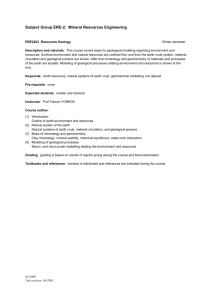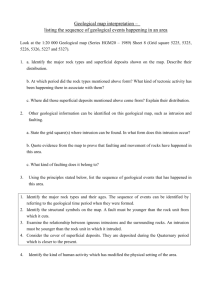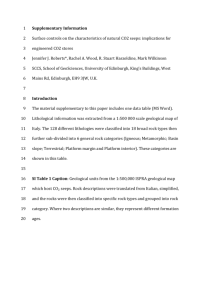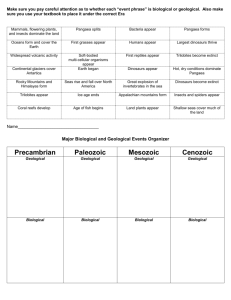Geological Map Interpretation
advertisement
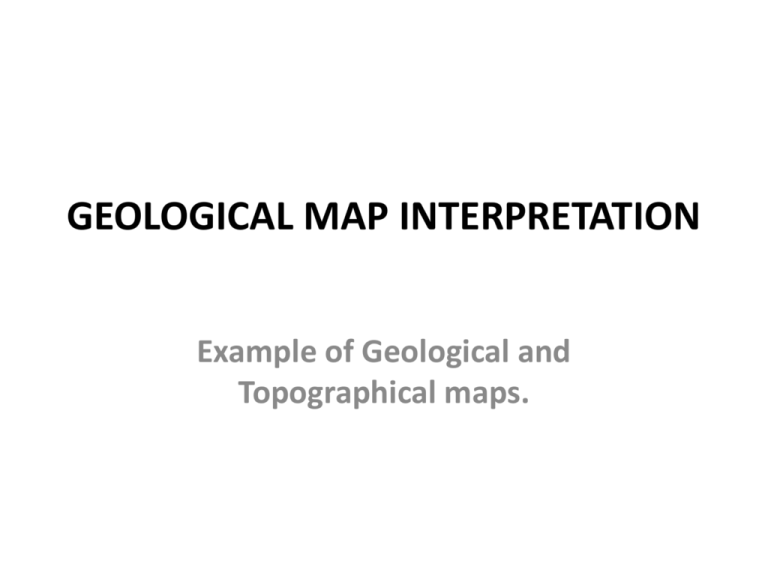
GEOLOGICAL MAP INTERPRETATION Example of Geological and Topographical maps. DESCRIPTION OF GEOLOGICAL MAP • • • • • • RECOMMEND METHOD Succession Structure Igneous Activity Geomorphology History USES OF GEOLOGICAL AND TOPOGRAPHICAL MAPS • Geological map shows the various rock types in an area. • Geological map shows geological structures which are very important in mineral, oil/gas and underground water exploration and other engineering works. • Topographical map shows the physical features of a place which are very useful in geological mapping. THE INFORMATION FROM WHICH MAP PLOTTING DATA IS DERIVED • • • • Outcrop exposures Exposures in cuttings and excavations Borehole logs Colour of ant-hills, soils etc. SCALES A scale of a map is the ratio between a distance on a map and a corresponding distance on the ground. HOW TO REPRESENT SCALES. • A scale of a map is always indicated on the map, and this is done in three(3) ways. • Verbal scale-This expresses in words the relationship between a map distance and a ground distance. Eg. 1cm represents 20m. • Representative fraction or Ratio scale. Eg1:20000, 1:50000, 1:125000,etc • Line or bar scale- this shows directly on the map the corresponding ground distance. ROCK STRUCTURE. • Horizontal strata-They conform to, or run parallel to the topographic contours. • Inclined strata-They rarely run parallel to contour lines. The inclination may be due to either the deformation of originally horizontal rock units , or deposition on originally inclined surface. • Dip-This is the angle of inclination which a line on the stratum in the dip direction makes with the horizontal. ROCK STRUCTURE CONTD. • Strike- It is a direction which can be measured and recorded as a compass bearing when part of the surface of the stratum is exposed to view. At right angles to the strike is the direction of maximum slope or dip. CREATING TOPOGRAPHIC PROFILESTHINGS TO CONSIDER. • First decide on the line that is of interest to you. • Pencil the line of your interest on your map. This is the line of section. • Place a scaled piece of paper along the line of section. • Mark clearly, the starting and ending points of the line of section. • Make a tic mark wherever the paper crosses a contour line on the map. • Connect the dots on the paper, this smooth continuous curve is the topographic profile. GENERAL PRINCIPLES OF GEOLOGICAL MAPPING. • Preparing to go to the field. • Things needed. • Uses of G.P.S(geographical positioning system) and geological compass. • Griding of topographical map. • Difference between traverse, outcrop, structural and geological maps. BASIC GEOLOGICAL MAPPING TECHNIQUES. • The tasks of a geologist in undertaking geological mapping of an area include, among other things: • The search for useful resources such as gold, diamonds, underground water or materials for constructional works. • The production of a geological map of an area (this is the main task). WHAT TO DO AT AN OUTCROP LOCALITY. • Date, and areas where traverses will be conducted for the day • Put on the G.P.S and take the G.P.S cordinates and give a number to this locality(this is the locality number of the outcrop eg.EM001/12) • Describe the outcrop-massive, weathered. Is the rock fine, medium or coarse grained? • Structural features of the outcrop-dip/strike etc. • Sketch any structural relationships. • Record samples and photographs taken. Carefully give a number to the sample(s) taken eg.EM001/1 SOME BASIC LAWS IN GEOLOGICAL MAPPING. • The law of superposition • The law of original horizontality--This law says that water-laid sediments are deposited in strata that are almost horizontal and parallel or nearly parallel to the surface on which they accumulate. • The law of original continuity. • The law of truncation and dislocation. • Law of cross-cutting relationship. MAPPING OF AREAS WITH POOR OUTCROPS-Things to consider. • Pay attention to excavated areas and road cuts. • Pay attention to the colour of anthills and soils. • Traverse along streams and rivers. • Visit hand-dug wells and bore-hole areas. • Visit high grounds. PRACTICALS • Traverse, outcrop, structural and Geological maps. • Griding of Topographic map • Plotting of G.P.S cordinates on topographic map. • Plotting of strikes and dips on topographic map. • Drawing of sections.



